HandEra 330
We've seen the future of Palm OS computing...
by Shawn Barnett
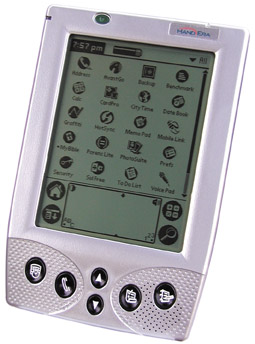
June 6, 2001
And it's name is HandEra. Coming from the makers of the original TRGpro, the new HandEra 330 ushers in a new name for the company, and a great new product for other Palm OS manufacturers to emulate. The 330 breaks new ground for Palm OS products: it has a higher-resolution, 240 x 320 screen; it sports a "virtual Graffiti area," one that slides out of the way, giving the screen a portrait orientation instead of a square; and it maintains backward compatibility with both Palm III-style cradles, as well as its little brother's CF slot (the TRGpro), while offering future compatibility with Palm's new SD slot (featured on the new m500 series). And by George, it has an absolutely real backlight, non-inverted, and actually useful in low-light situations. It's an impressive product from a small group of engineers who should be very proud, and it deserves a much closer look.
The HandEra 330 comes from one of the smaller players among the Palm OS licensees, but they are not new to the Palm platform. TRG, or Technology Resource Group, was their name before their April 20 announcement. They were a fast-turnaround design house for electronics manufacturers, and along the way they took an early interest in the new handheld from Palm Computing. Soon they were known for their innovative software and hardware products for the Pilot, most popular of which was their memory expansion card. Currently, at the launch of their second handheld, they're not much bigger than Palm Computing was at the launch of the Pilot in early 1996.
HandEra's 330 really does set them apart from the larger, more conservative Palm OS manufacturers. Their first entry into producing a complete Palm OS product came in 2000 with the TRGpro, which had a Compact Flash slot and a real speaker for playback of .WAV files. It was aimed at the business user, and it was designed conservatively enough. It didn't really look much different from a Palm III. The HandEra 330 makes more strides internally than physically, and I'll attempt to cover the main highlights here.
Walkaround
The first thing you notice is that it looks familiar. It also has basically the same dimensions as a Palm III, with the same cradle and the same flip lid. Raise that lid and some differences become apparent. First, the front bezel is silver, almost chrome, with an industrial look. The buttons are oval and surrounded by a dot pattern, which on the right becomes a pattern of holes for the built-in speaker. The scroll buttons are no longer a rocker, like on the TRGpro, but separate buttons. We're seeing this on most new Palm OS products, and it seems to work more reliably. Above left is a notch and window for an LED, and there's a small green oval with a dimple in the middle for easy activation with a stylus tip. The four application and scroll buttons are cupped for the same reason. To the right of the power button is the HandEra logo, and right behind that the microphone slot peeks out (there is no external mic jack, only a condenser microphone).
Most notable about the front are two things about the screen: there's no Graffiti area when the unit's off, which I'll explain soon, and the screen and buttons are absolutely center on the product. This is a first for a Palm OS product, since all previous manufacturers have set the screen a millimeter or more left or right.
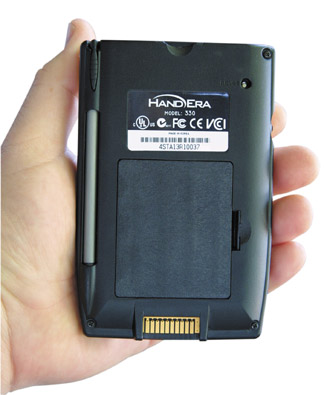
Flipping the unit over, many differences are apparent compared to a Palm III. There is no slide-away cover for the HotSync area. This was never necessary; it was mostly for the user's peace of mind. Space being at a premium in these later handhelds, it is no longer important. On the left, part of what usually conceals the stylus area is now partially open, perhaps for logos on the stylus, perhaps for weight reduction. The most obvious difference here is the very large battery door. The HandEra 330 uses four AAA batteries oriented vertically instead of just two oriented horizontally, a complete departure from other Palm OS devices. Another thoughtful innovation was to open up the area around the reset button. Instead of having to unscrew the tip of the stylus to find a narrow reset pin, users need only insert the tip of the stylus into the perfectly contoured hole. The button is recessed enough that accidental activation is unlikely. It is considerably less troublesome, and a welcome design feature.

Wrapping around to the left of the unit, we have three more features. There is a toggle wheel and a "backout" button. These can be used to toggle through applications, or addresses in the address book. Selections are made by pressing in on the toggle, which looks remarkably like the toggles on many Windows CE devices. You can also backtrack with the backout button, a feature missing on the early Sony CLIE (but present on the new N710C). On the HandEra, these two items each have another purpose. Hold down the backout button for a few seconds, and you're taken to the record application. If you continue to hold, recording commences after the confirmation beep, until you release the button. Press and hold the toggle, and the contrast control appears on screen. Adjustment can then be made with the toggle, scroll buttons, or with the onscreen slider. The third feature on the side is a power jack, another Palm OS first. More on that soon.
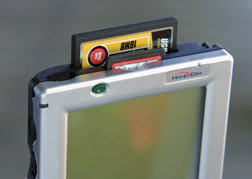
On the top of the unit are the IrDA port and both Compact Flash (CF) and SecureDigital (SD) slots. The CF slot can take Type I or II CF cards, including the monster 1GB MicroDrive. The SD slot can take SD cards or the thinner MultiMediaCards (MMC). This is a neater solution than existed on the TRGpro, which had a dark, but slightly translucent door over the CF slot and IrDA port which could be easily lost. The 330's design includes dummy plastic blanks for either slot that can also be misplaced, but at least the design still looks more finished with an empty slot.
Despite it's metallic-looking face, the unit has an all plastic casing. The flip cover is identical to the Palm III and TRGpro, something many will like, and many will not. I happen to love this flip cover for its simplicity and its durability.
Processor
The 330 has a Motorola Dragonball VZ running at 33MHz, like all the recent Palm OS handhelds. Its performance is snappy and on par with the Visor Edge when tested with Neal Bridges' Benchmark 2.0. Both test at 244% the speed of a Palm IIIxe. As a side note, the Palm m500 and m505 test at 154% and 156%, much slower than the Edge and 330. I'm told by Neal Bridges that even though the m500's run Palm OS 4.0, they are indeed slower than the Edge and 330, since his tests are OS independent; still OS 4 is quicker at some tasks that the benchmark test cannot measure.
RAM
The 330 comes with 8MB RAM, and 2MB Flash, so the OS remains upgradeable, and will allow for upgrade to OS 4.0 whenever that's available. With its special features, I'm sure that upgrade will have to come from HandEra.
Screen
It's the quarter-VGA (240 x 320) screen that's the big story with this product. That they were able to keep existing software applications, originally written for 160 x 160 screens is quite an achievement.
"We went to Palm eight months ago saying we were going to do quarter VGA," said Mike Walter, HandEra's Vice President of Software Engineering. "And they said, 'Well, that can't be done, that's one and a half times bigger.' But I was pretty sure we could. And we just got Palm Certified about three or four days ago. Some of your drawing programs will need to be converted, but that was a compromise we had to make.
"We've got an SDK that's really easy for developers to convert so they can write apps that will run both on standard Palms and our HandEra 330 without having to have two versions," said Walter.
HandEra chose the 240 x 320 screen to keep with their tradition of sticking with standards. "Wireless is going to be expecting some kind of a standard screen size. So our whole goal has been to be industry standard with the Compact Flash slot, and now the SD slot," said Mike Downey, President and CEO of HandEra. "There are a lot of advantages to staying standard."
While it is arguable that Palm's 160 x 160 is more of a standard with the millions of units in the market, quarter-VGA, used on the Pocket PC, is certainly more of an industry standard than Sony's new 320 x 320 screen, which quadruples the 160 x 160 Palm screen. The 330's fonts are finer than on the 160 x 160 screen but not as fine as on the Sony, the smallest of which are too fine. The 330 is just about right.
HandEra has also taken better advantage of their many pixels by offering eight fonts instead of the usual three, while the new Sony, despite its greater resolution, sticks with three. The smallest of these fonts is very small indeed, allowing the full name and company name along with the phone number to display in the Address Book's list view for most entries. Granted, the font's so small it's only we extremely nearsighted who will use it, but it sure is cool that they gave us the option.

Certainly earning the greatest shout of "Finally!" is the virtual Graffiti area, which can be moved out of the way to give more screen area for portrait or even landscape views. Palm-size Windows CE and Pocket PCs have been able to slide the input area out of the way from the beginning. On the HandEra, the arrow that indicates separation between the letter and number entry areas is a slightly different arrow that also performs the function of sliding the Graffiti area out of the way. Though it seems silly to mention, it may be the first sliding-drawer-type animation on a Palm device. Apple Newtons did this nine years ago, with an accompanying swish sound. And it came long before programs on the PC started sliding menus, like Encarta. It's trivial, but adds a touch of class, and it's indicative of where HandEra is headed with their Palm OS devices. Smart design, not just conservative "me too" capitulation to the status quo.
Contrast control is in the upper left corner of the Graffiti area, and the volume control is in the upper right. All else looks like the static Graffiti area on other Palms. Slide the Graffiti area down and you still have a small portion of the screen for the crucial Application and Menu icons, plus the little arrow that brings the Graffiti area back into view. In programs that can rotate the screen to landscape mode, the Graffiti area is still as tall, but it's a lot wider, taking up a lot of the screen real estate. Minimized will be the best solution in this case, though entering characters will only be possible with it maximized.
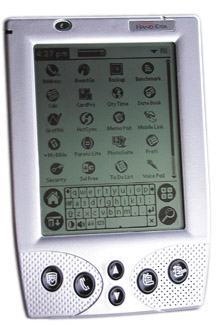
There is a replacement for the onscreen keyboard that on other Palm OS devices takes up most of the small square screen. This one fits right inside the Graffiti area, filling the writing area, but leaving the four standard icons left and right untouched. You can tap the characters if you like, or write Graffiti right over it if you choose. No overlays needed here, innovative design sense is used instead. This is the coolest virtual keyboard on any Palm device. Some might find it too small, but that's part of its beauty.
Which brings us to the backlight. Here they join Sony's original CLIE by abandoning the almost worthless inverted backlight. I've gone on about the inverted backlight in other reviews, so I will spare you the diatribe. Visit our website and read the Edge review (the Edge is excellent, but like most other Palm OS devices is tainted by this "feature"), and see the photos in the Screen Test for more. The HandEra 330's backlight is absolutely superb. It's even helpful in only mildly low light, where inverted backlights actually make it more difficult. The background lights up a bluish-green, and the pixels remain mostly black, sharp against the lighted background. The virtual Graffiti area seems even more useful because it is completely backlit, and each stroke appears in black ink against a glowing background. Not only can you see where you're supposed to write while composing that email in the dark, you can see each stroke as you write it. It's so simple, but it looks like magic. Bravo, HandEra.
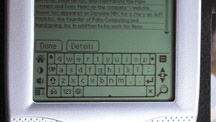
The stylus is the same exact stylus on the TRGpro, Palm III, and Palm VII. It still has the reset pin, but because of the open reset area, it's unnecessary. All you need is the stylus tip.
The cradle is also the same as the TRGpro, except it has the HandEra logo. They stuck with this form factor and the serial connection because so many of their business customers said they needed the ability to continue connecting to the Windows 95 machines in their offices. Windows 95 does not sufficiently support USB, nor does a lot of old corporate hardware, so HandEra saw this as crucial. They do say, however, that this will be their last serial-only handheld. Future versions will likely use something like Palm's new combination USB/serial connector.
Alarm
The traditional alarms have been augmented with a flashing red light at the top left front edge of the unit. It flashes slow red while the unit is on displaying the alert, and when the unit sleeps between repeated alarms, it flashes more quickly to spare the battery. As far as I can tell, this continues until the alarm is acknowledged. This is a feature that has been long overdue, and is not included in Palm's implementation of the flashing light on the m500 series.
Battery
The alarm light also serves as a charge indicator light. Charge indicator? Didn't I say it was powered by four AAA batteries? Yes, that's one option. You can also load their lithium-ion battery pack. With this option, the unit can charge in the cradle or via the AC jack on the left side that I mentioned earlier. And if you have alkalines in place and the unit is either in the cradle or plugged directly into the charger, no power is drawn from the batteries; they are bypassed and the incoming current powers the unit, conserving batteries for mobile use. I told you this thing was cool. The unique separate power jack means that you can be charging the unit or using wall power while typing or working on the web indefinitely, because the HotSync port is left available for these peripherals. Another obvious benefit is in using the 330 for long-term scientific monitoring. Just plug it into the AC adapter and leave it in place for uninterrupted use (Californians might want to leave the Li-ion batteries in place for the occasional blackout).
The extra batteries are also helpful for powering peripherals plugged in through the CF card. Where the Springboard expansion port can provide up to 100 mA to modules, the HandEra's CF slot can give up around 500 mA, according to HandEra's Downey.
But doesn't having two extra batteries increase the HandEra 330's weight? I'll let Mike Walter answer that one: "Our new screen is so much lighter than the standard 160 x 160 screen that the 330 is actually lighter with four batteries than the TRGpro is with two batteries." Put the Lithium Ion pack in, and it's even lighter. Not bad. The TRGpro is 6.6 ounces, the 330 is 6.5 ounces, and the Palm IIIx is 6.3 ounces, all with batteries and the flip covers in place.
Expansion
While the Palm m500 is making a big splash with its SD expansion slot, the HandEra 330 is making a bigger splash with both Compact Flash and Secure Digital expansion slots. HandEra's approach to both expansion technologies is different from Palm's. With a Palm, users don't have access to the file structure of the expansion cards; they're only able to read from and write to specific directories that are invisible to them. I know this because the HandEra shows directories in standard FAT tree structure, as they did with the TRGpro, and I was able to observe the directory structure Palm uses by swapping an SD card from the m500 into the 330. Using HandEra's new CardPro software (renamed from CFpro on the TRGpro), I can view and modify the raw contents of either CF or SD cards, something that cannot be done on the m500. You can quickly copy contents to or from either card, and you can even copy from card to card. With AutoCF, you can load programs onto the Compact Flash card under the AutoCF directory and they run from the card just like a Springboard module.
"Whereas Springboard RAM modules are more like a memory extension," says Walter, "these actually act more like a program on a hard drive. So when you click on them, they get downloaded into RAM, and when you're done, they get deleted from RAM." That means you have to have the space in onboard RAM to run a program from CF. However, if you're reading data from the CF, say a large book, the program is smart enough to download only the data you need from that book, so multi-megabyte files can still be easily accessed from the CF card. Palm OS 4.0 will offer new ways for programmers to access CF and SD data directly without the help of programs like AutoCF.
For compatibility with upcoming peripherals and data cards made for Palm, having that SD slot is a great benefit. SD, unfortunately, is not as fast as CF. "SD is serial, whereas CF is parallel. It's high speed serial, but it can't go at the high speed because of the DragonBall," said Walter. So it's about half to three-quarters as fast as CF for data transfer rates. Still, it's plenty fast for SDIO peripherals, according to Walter.
Another interesting point about the SD slot is that HandEra stuck with what they believe is the standard stipulated by the SD Card Association, where the label faces the user as the card is inserted. Palm chose to face the label away from the user as it is inserted. This was most likely a design space issue for both companies. It could be a problem for HandEra, since most peripherals manufacturers will be designing products for the Palm instead of for their unit. Cameras that face only one direction, for example, would face away from the user in a Palm and toward the user in a HandEra.
There is also a Backup application that's loaded in Flash, so even if the battery completely dies, all you need to do is install a new set of batteries and restore from a backup on your CF or SD card. Here, by the way, is where the speed difference between the two types of card really shows up. I backed up 5,964K to CF in 11 seconds, then restored it in 17 seconds. The same data took one minute 34 seconds to backup to SD and one minute 18 seconds to restore. SD is a lot slower indeed.
Being a machine aimed primarily at the business market, the HandEra 330 has a voice recorder built in. Called the Voice Pad, it records in .WAV files. One minute's worth of speaking results in a 479K file, which can then be played back, copied to a CF or SD card, and listened to on any PC. You can also easily record directly to SD or CF cards, to make longer recordings without cutting into your valuable system RAM.
The 330's only competition in this area is a Pocket PC, the Kyocera Smartphone, or a Visor with an add-on module. Though the Sony has a more sophisticated audio playback system, there is no mic or mic jack for recording of any kind, and no speaker to play notes back with (though there is a headphone jack). The 330 has it all wrapped up for simple recording, storage, and playback of voice. Its small mic isn't quite as good as say a nice microcassette recorder, but it'll capture basic room conversation within about five feet. For playback, the speaker's just a little scratchy, but it's still pretty audible for such a small device.
Upgrades are applied more easily than I've ever experienced with any Palm. I just downloaded the file from HandEra's website, unzipped it, copied it onto a CF card, and ran the install procedure from the CF card. It took about sixty seconds. The unit will ship with OS 3.5.2, but 4.0 will ship at some point as yet unannounced. 4.0 will allow upload of data directly onto the CF card; in the meantime to effect an upgrade with this method, users will need a CF card reader/writer.
The HandEra 330 is the Palm IIIx I always dreamed of. It has my favorite flip lid, it is substantial enough to hold, and it has all the screen features I've ever wanted, some of which I didn't even know I wanted. With expansion and easy backup, this is the power user's Palm of choice. I've said that about the Palm VIIx as well, and it's still true, but if you don't need wireless, the 330 is it. You should be able to add a PocketSpider modem through the CF card if wireless is still important.

It's capable of so much more than a regular Palm that each user will be able to make it their own machine. The ability to choose from an array of fonts takes you half way there, and that virtual Graffiti/keyboard combination that slides out of the way just about completes it. Because the unit comes bundled with a full version of QuickOffice, with the ability to rotate the screen to landscape, a new dimension is added to your style of working.
The small HandEra team has taken Palm OS computing beyond the conservative constraints of its current state, giving it features many have long requested. Here's hoping the competitive spirit spurs HandEra's competitors into following suit and giving us more full-featured and capable handhelds. In the meantime, if you want the future of Palm OS computing today, look no further than the HandEra 330. US$349. Available now at the HandEra website.
-Shawn Barnett
Questions? Comments?
Back to Palm Section

